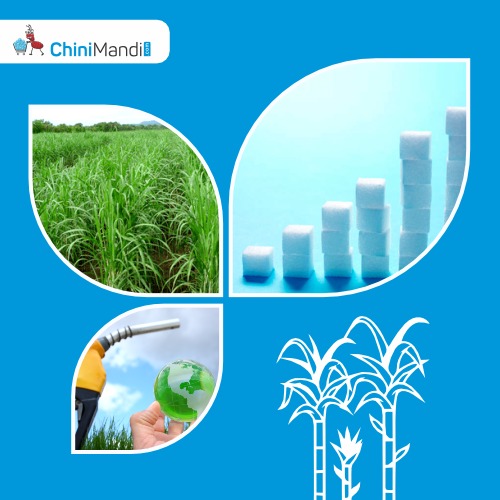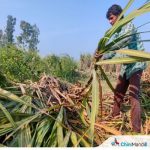A global agricultural economy’s main driver, the sugar industry is changing
dramatically to produce more ethanol. The need for cleaner energy sources, a
decrease in reliance on fossil fuels, and the development of a more lucrative and
sustainable sugar industry are the driving forces behind this change. This analysis
looks at recent policy initiatives, assesses the current situation of the sugar-to-
ethanol industry, and suggests ways to make the industry stronger.
The Sugar Industry’s Evolution: Throughout the past ten years, the government has
been a major contributor to the industry’s support. Its general health has been
enhanced by policies meant to stabilize sugar prices, encourage exports, and provide
incentives for the production of ethanol. Consequently, during this time, no sugar
factory has experienced financial difficulties. The amount of outstanding debt has
decreased, and the sector is expected to grow even more. Notable advancements
consist of:
1. Financial Stability: The government’s actions have been instrumental in keeping
sugar factories out of financial trouble. The industry’s general state of health has
greatly improved as a result of a combination of price stabilization policies, export
promotion, and incentives for ethanol production. Due to the significant decrease in
outstanding debt, the industry is now well-positioned for future expansion and
innovation.
2. Export Promotion: The Government of India, have implemented export policies
that include subsidies in order to efficiently manage domestic supply and support
international trade. These policies have played a key role in keeping sugar mills out
of financial trouble, maintaining domestic sugar prices, and lowering surplus sugar
stocks that might have otherwise caused market prices to drop.
3. Ethanol Blending Program (EBP): Sugar mills now have access to a new and
profitable source of income thanks to the implementation of ethanol blending
policies. This program greatly lessens the nation’s reliance on imported fossil fuels
while also providing a diverse range of revenue streams for the sector. The
government has shown a strong commitment to this transition by setting the lofty
goal of blending 20% ethanol (20% EBP) with gasoline.
4. Tax Incentives: Governments have implemented income tax relief measures to
support the industry. The sugar producers and farmers have benefited financially
from the exemption from income tax on Fair and Remunerative Price (FRP) and
Statutory Minimum Price (SMP) payments, which has improved profitability and
supported rural livelihoods.
5. Supply Management: The stability of the market has been largely dependent on
the prudent management of sugar and ethanol reserves. Both shortages and
oversupply scenarios have been successfully avoided thanks to this well-balanced
strategy, guaranteeing a stable market environment for both producers and
consumers.
6. Interest Subsidy Schemes: Large-scale ethanol projects have been made possible
by the introduction of interest subsidies for the construction of new ethanol plants.
The financial burden on sugar mills has been greatly eased by these interest
subsidies, which has sped up the industry’s transition and encouraged large
investments in ethanol production facilities.
7. Flexible Raw Material Usage: Government have permitted the use of various
feedstocks for the production of ethanol, realizing the need for operational
flexibility. This includes choices like food grain, B-heavy molasses, C-heavy
molasses, and sugarcane juice (SCJ), which give producers the freedom to tailor their
production methods to the state of the market and the availability of raw materials.
Timeline of Important Events:
* 2010–2015: First ethanol blending programs introduced
* 2016–2018: Export promotion policies and tax incentives implemented
* 2019–2021: Interest subsidy schemes for ethanol plants launched
* 2022–Present: Advocates for a 20% ethanol blending target and feedstock
diversification
Present State of Production:
The sugar industry is able to meet the demand for both sugar and ethanol, as
evidenced by recent production figures:
Domestic sugar production was initially estimated at 291 lakh metric tonnes (LMT)
in the season 2023-24.
•The industry intended to divert 34 LMT of sugar for the production of ethanol,
demonstrating the importance of ethanol in the output mix of the sector.
321 LMT of sugar were produced in actuality, exceeding estimates, with 24 LMT
being diverted for the production of ethanol.
•At the start of the next season, an estimated 90 LMT of sugar is anticipated to
remain, suggesting a healthy balance between production and consumption. These
numbers highlight the sector’s flexibility in responding to shifting consumer
demands and governmental regulations. The sugar and ethanol markets are in a
delicate balance, with neither commodity facing oversupply or depletion thanks to
efficient production and diversion management.
Stakeholder analysis reveals that:
Farmers want stable prices and demand for sugarcane;
Sugar Mills diversify to become profitable;
Oil Companies strive to meet blending targets and enhance infrastructure;
Government strikes a balance between energy independence, food security, and
environmental goals;
Consumers seek affordable and sustainable fuel options.
Comparative Analysis:
Brazil’s ethanol program, which was started in the 1970s, shows that it can
successfully achieve high blending rates over the long run and create a sizable
market for flex-fuel vehicles. The corn-based ethanol sector in the United States
provides information about large-scale production and the difficulties associated
with the food vs. fuel debates.
Opportunities and Challenges:
1. In spite of the notable advancements, the sugar-to-ethanol sector still faces a
number of obstacles that must be overcome to guarantee its long-term viability and
expansion.
Policy Uncertainty: The temporary ban on SCJ and BHM ethanol, while necessary
to ensure adequate sugar supply, created uncertainty for producers who had invested
heavily in ethanol production capacity. This highlights the need for more predictable
and consistent policy frameworks.
2. Ethanol Pricing: There is an urgent need to develop a more dynamic and market-
responsive pricing mechanism for ethanol, particularly for SCJ and BHM-based
ethanol. (Prices of SCJ and BHM-based ethanol did not increase last year due ban)
Aligning them with the market prices of sugar and the FRP of sugarcane. Prices
should reflect current market conditions and ensure profitability for producers while
remaining competitive with alternative fuels.
3. Infrastructure Bottlenecks: Limited ethanol unloading capacity at Oil Marketing
Companies (OMCs) has led to significant delays and inefficiencies in the supply
chain. Addressing these bottlenecks is crucial for achieving higher blending targets
and improving overall system efficiency. Enhancing the ethanol unloading capacity
at OMCs is critical for achieving ambitious EBP targets. The current unloading
process, which can take 8-15 days, causes delays in payments and inefficiencies in
the supply chain. Streamlining this process will benefit both sugar mills and OMCs.
4. Payment Delays: The current 21-day payment cycle for ethanol deliveries can
create cash flow challenges for producers, particularly smaller operations.
Streamlining this process could significantly improve the financial health of ethanol
producers.
5. Raw Material Supply: Ensuring a consistent supply of raw materials for ethanol
production is crucial for maximizing plant utilization and meeting blending targets.
This requires careful coordination between agricultural policies, sugar production,
and ethanol demand.
6. Diversification Opportunities: Sugar mills having ethanol projects have the
potential to diversify into other bioenergy products, such as compressed biogas
(CBG) and hydrogen. Exploring these avenues could provide additional revenue
streams and contribute to a more sustainable energy mix contributing to a more
diversified and sustainable future for the industry.
7. Feedstock Diversification: Encouraging the development of multi-feed ethanol
plants that can process various raw materials would ensure a steady supply even if
one feedstock faces shortages. Government support through incentives and technical
assistance could accelerate this transition.
Future Scenarios:
1. High Growth: Successful implementation of 20% blending, diversification into
other biofuels, and export of ethanol technology.
2. Moderate Growth: Partial achievement of blending targets, limited diversification,
and focus on domestic market.
3. Stagnation: Policy uncertainties lead to underinvestment and failure to meet
blending targets.
Policy Recommendations:
To address these challenges and capitalize on the opportunities present in the sugar-
to-ethanol industry, we propose the following policy measures:
1. Clear and Consistent Ethanol Policy:
Establish a long-term (e.g., 10-year) policy framework outlining the government’s
commitment to ethanol blending and production targets.
Clearly define the rules for using different feedstocks like sugarcane juice,
molasses (B-heavy and C-heavy), and food grains, considering factors like sugar
price stability and food security.
This will provide certainty to investors in the sugar and ethanol sectors, allowing
them to make informed decisions about production capacity and technology
adoption.
2. Flexible Feedstock Approach:
Encourage the development of multi-feedstock ethanol plants capable of
processing sugarcane juice, molasses, and other feedstocks like broken rice or corn.
Provide incentives for conversion of existing single-feedstock plants to enable
them to handle a wider range of raw materials.
This flexibility will ensure optimal utilization of production capacity and continued
ethanol production even if sugarcane supplies are limited.
3. Dynamic Ethanol Pricing Mechanism:
Implement a transparent pricing mechanism for ethanol that reflects changes in
market conditions, including sugar prices, the Fair and Remunerative Price (FRP) of
sugarcane, and production costs.
Regularly review and adjust ethanol prices to ensure they remain competitive with
fossil fuels and provide a fair return on investment for producers.
This will incentivize continued investment in ethanol production and capacity
expansion.
4. Infrastructure Development:
Increase ethanol unloading capacity at Oil Marketing Company (OMC) depots to
reduce turnaround times for tankers delivering ethanol for blending.
This could involve investments in additional storage tanks, faster unloading
systems, and improved logistics management between sugar mills and OMCs.
Streamlining the unloading process will improve supply chain efficiency and
expedite payments to producers.
5. Expedited Payment Cycle:
Reduce the current payment cycle for ethanol deliveries from 21 days to a shorter
timeframe, ideally within 8 days.
This can be achieved through digital payment systems and streamlined approval
processes.
Faster payments will improve cash flow for producers, particularly smaller ones,
and incentivize them to continue ethanol production.
6. Research and Development Support:
Provide incentives for research and development in advanced biofuel technologies,
including second-generation ethanol production from agricultural residues. This will
help future-proof the industry and open new avenues for sustainable fuel production.
7. Promotion of Bioenergy Diversification:
Encourage sugar mills to explore and invest in other bioenergy projects, such as
compressed biogas (CBG) and green hydrogen production. This can be supported
through targeted incentives, policy support, and public-private partnerships.
8. Supply Chain Optimization:
Invest in logistics infrastructure to improve the transportation and distribution of
ethanol from production centers to blending facilities. This includes upgrading rail
and road networks and exploring pipeline transport options for ethanol.
9. Skill Development:
Implement comprehensive training programs to develop a skilled workforce capable
of operating and maintaining advanced ethanol production facilities. This will ensure
the industry has the human capital needed to support its growth and technological
advancement.
10. Public Awareness Campaigns:
Launch initiatives to educate the public about the benefits of ethanol blending,
including its environmental and economic impacts. This will help build public
support for ethanol use and promote responsible consumption.
Environmental Considerations: Achieving Sustainability
While promoting ethanol production, it’s crucial to address potential environmental
concerns to ensure the long-term sustainability of the industry:
Water Management: Implement strict water management practices in sugar mills
and ethanol plants to minimize water consumption and promote recycling. This
includes adopting water-efficient technologies and exploring drought-resistant
sugarcane varieties.
Waste Management: Develop and enforce guidelines for the proper disposal of
stillage and other byproducts of ethanol production to prevent environmental
contamination. Explore innovative ways to utilize these byproducts, such as in
biogas production or as organic fertilizers.
Energy Efficiency: Encourage the adoption of energy-efficient technologies in
ethanol production to reduce the carbon footprint of the industry. This could include
the use of renewable energy sources in production processes and the implementation
of cogeneration systems.
Life Cycle Assessment: Conduct comprehensive life cycle assessments of ethanol
production to ensure that the environmental benefits outweigh the costs. This will
help identify areas for improvement and demonstrate the sustainability credentials
of the industry.
Sustainability Metrics:
Reduce water consumption in ethanol production by 20% by 2030
Achieve carbon neutrality in ethanol production by 2040
Increase use of renewable energy in ethanol plants to 50% by 2035
International Cooperation and Knowledge Sharing
Fostering international cooperation can significantly benefit the sugar to ethanol
industry:
1. Technology Transfer: Facilitate technology transfer and knowledge
sharing with countries that have advanced ethanol production capabilities,
such as Brazil and the United States. This can help accelerate the adoption
of best practices and innovative technologies.
2. Joint Research Initiatives: Establish joint research programs with
international partners to develop innovative solutions for ethanol
production and utilization. This collaborative approach can pool resources
and expertise to address common challenges.
3. Trade Agreements: Negotiate favourable trade agreements to promote the
export of ethanol and related technologies. This can help create new
markets for ethanol producers and facilitate the exchange of expertise and
technology.
Monitoring and Evaluation
To ensure the effectiveness of policy measures, a robust monitoring and
evaluation framework is essential:
Data Collection: Implement a comprehensive data collection system to
track ethanol production, blending rates, and market dynamics. This will
provide valuable insights for policy-making and industry planning.
Regular Policy Reviews: Conduct periodic reviews of ethanol policies to
assess their impact and make necessary adjustments. This flexible
approach will ensure that policies remain relevant and effective in a
changing market environment.
Stakeholder Feedback: Establish mechanisms for regular feedback from
industry stakeholders to identify challenges and opportunities for
improvement. This inclusive approach will help ensure that policies are
practical and address real-world concerns.
Call to Action:
Government: Establish a clear, long-term ethanol policy framework and invest in
necessary infrastructure
Sugar Mills: Invest in multi-feedstock ethanol plants and explore diversification
into other biofuels
Oil Companies: Accelerate the upgrade of ethanol unloading and blending facilities
Research Institutions: Focus on developing more efficient ethanol production
technologies and sustainable practices
Consumers: Support the transition to ethanol-blended fuels and advocate for
sustainable transportation options
By implementing these recommendations and fostering collaboration among all
stakeholders, we can build a resilient, sustainable, and prosperous sugar to ethanol
industry that contributes significantly to energy security, rural development, and
environmental sustainability.
Conclusion:
The sugar-to-ethanol industry stands at a critical juncture, with immense potential to
contribute to energy security, environmental sustainability, and rural economic
development. By implementing a comprehensive and forward-looking policy
framework, governments can create an enabling environment for the industry to
thrive.
Key to this transformation is a balanced approach that considers the interests of all
stakeholders – from sugarcane farmers to ethanol producers, oil marketing
companies, and end consumers. Policies must be flexible enough to adapt to
changing market conditions while providing the stability needed for long-term
investments.
The shift towards a more diversified sugar industry, with a strong focus on ethanol
production, represents a paradigm shift in agricultural and energy policy. It offers a
unique opportunity to address multiple challenges simultaneously – reducing
dependence on fossil fuels, managing agricultural surpluses, and creating new
economic opportunities in rural areas.
However, the success of this transition depends on careful planning, consistent
policy implementation, and ongoing collaboration between government, industry,
and research institutions. By addressing the challenges and capitalizing on the
opportunities outlined in this analysis, the sugar-to-ethanol industry can play a
pivotal role in shaping a more sustainable and prosperous future.
As we move forward, it is essential to maintain a long-term perspective, balancing
immediate economic gains with broader sustainability goals. The sugar-to-ethanol
industry has the potential to be a model for sustainable agro-industrial development,
demonstrating how traditional agricultural sectors can evolve to meet the challenges
of the 21st century.
By strengthening the sugar-to-ethanol industry through thoughtful policy advocacy
and addressing related issues with innovative solutions, we can create a more
resilient, sustainable, and prosperous agricultural sector that contributes
significantly to national energy security and economic growth. The journey ahead is
complex, but with concerted efforts and a shared vision, the sugar-to-ethanol
industry can emerge as a beacon of sustainable development and economic progress.
Disclaimer: The views and opinions expressed in the article by Dilip Patil, Managing Director of Samarth SSK Ltd., are solely his own.
















